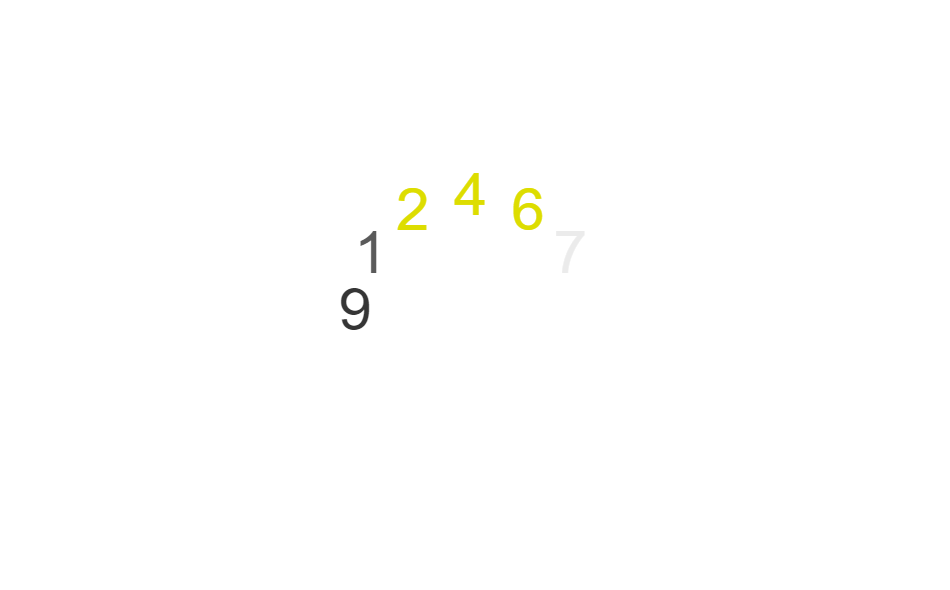Rapid Visual Processing

The Rapid Visual Processing task paradigm (RVP) is a serial detection task where test participants see a stream of single digits presented at a rate of about 100 items per minute. The task is to detect a specific sequential pattern or single target (the signal). A typical pattern is the sequence of three consecutive odd numbers or three consecutive even numbers (Wesnes, 1984). To detect this pattern task, categorical classification of the digit is required and the participant must memorize the previous two digits. A more simple task would be to detect the digit ‘0’ among the digits 1-9. This implementation of the RVP task can be configured to present digits either on the same screen location (original RVP) or next to each other in a circular layout. This variation allows the participant to see the most recent items which specifically reduces demands on working memory.
The RVP paradigm is widely used to measure sustained attention to visual stimuli at different levels of task complexity. While sustained attention, stimulus discrimination, and go/no-go response (Donders, 1969) is always required to accomplish the task, the introduction of the serial target pattern adds the recruiting of working memory and higher level stimulus classification processes (Posner, 1967). The three consecutive odd or even digits resemble the N-Back task where participants also have to memorize the last 2 items in order to detect a 3-back condition. But in addition to N-Back, the RVP task requires categorical classification at a fast pace, and in this sense its nature becomes more of a continuous performance task where participants have to perform over a prolonged time under stress. Those conditions are known to accelerate the decreasing performance over time (Parasuraman, 1979).
The RVP task paradigm has been shown to be sensitive to cognitive dysfunction due to sleep deprivation (Csipo et al, 2021), drug effects, ADHD (Gau SS-F et al, 2014). and long COVID (Sijia et al, 2022). RVP is also used as a stimulation task for blocked functional fMRI analysis (e.g. Neale et al., 2015).
Publications
Csipo, T., Lipecz, A., Owens, C. et al. Sleep deprivation impairs cognitive performance, alters task-associated cerebral blood flow and decreases cortical neurovascular coupling-related hemodynamic responses. Sci Rep 11, 20994 (2021).
Donders, F. C. (1969). Over de snelheid van psychische processen [On the speed of psychological processes]. In W. Koster (Ed.), Attention and Performance: II (Original work published 1868). Amsterdam: North-Holland.
Gau SS-F, Huang W-L. Rapid visual information processing as a cognitive endophenotype of attention deficit hyperactivity disorder. Psychological Medicine. 2014;44(2):435-446.
Kane, M. J., Conway, A. R. A., Miura, T. K., & Colflesh, G. J. (2007). Working memory, attention control, and the N-back task: a question of construct validity. Journal of Experimental Psychology. Learning, Memory, and Cognition, 33(3), 615-622.
Neale C, Johnston P, Hughes M, Scholey A. Functional activation during the rapid visual information processing task in a middle aged cohort: an fmri study. Antal A, ed. PLoS ONE. 2015;10(10):e0138994.
Parasuraman R. Memory load and event rate control sensitivity decrements in sustained attention. Science. 1979;205:924–927.
Posner, M.I., & Mitchell, R.F. (1967). Chronometric analysis of classification. Psychological Review, 74, 5. 392-409.
Sijia Zhao, Kengo Shibata, Peter J. Hellyer, William Trender, Sanjay Manohar, Adam Hampshire, Masud Husain, Rapid vigilance and episodic memory decrements in COVID-19 survivors, Brain Communications, Volume 4, Issue 1, 2022, fcab295, https://doi.org/10.1093/braincomms/fcab295
Configuration Options
| Digit Size | : | in mm |
| Stim Time | : | in ms |
| Mask Time | in ms (0 is no mask) | |
| Blank Time | in ms (0 is no blank) | |
| Min RT | in ms | |
| Late RT | in ms | |
| Max RT | in ms | |
| Stimulus Position | center or on circle | |
| Stimulus Trace | 1 or more | |
| Signal Probability | 0 – 100% | |
| Number Signals | Signals per segment | |
| Number of Segments | 1 or more | |
| Feedback | wrong, late, or all | |
| FB Time | in ms |
